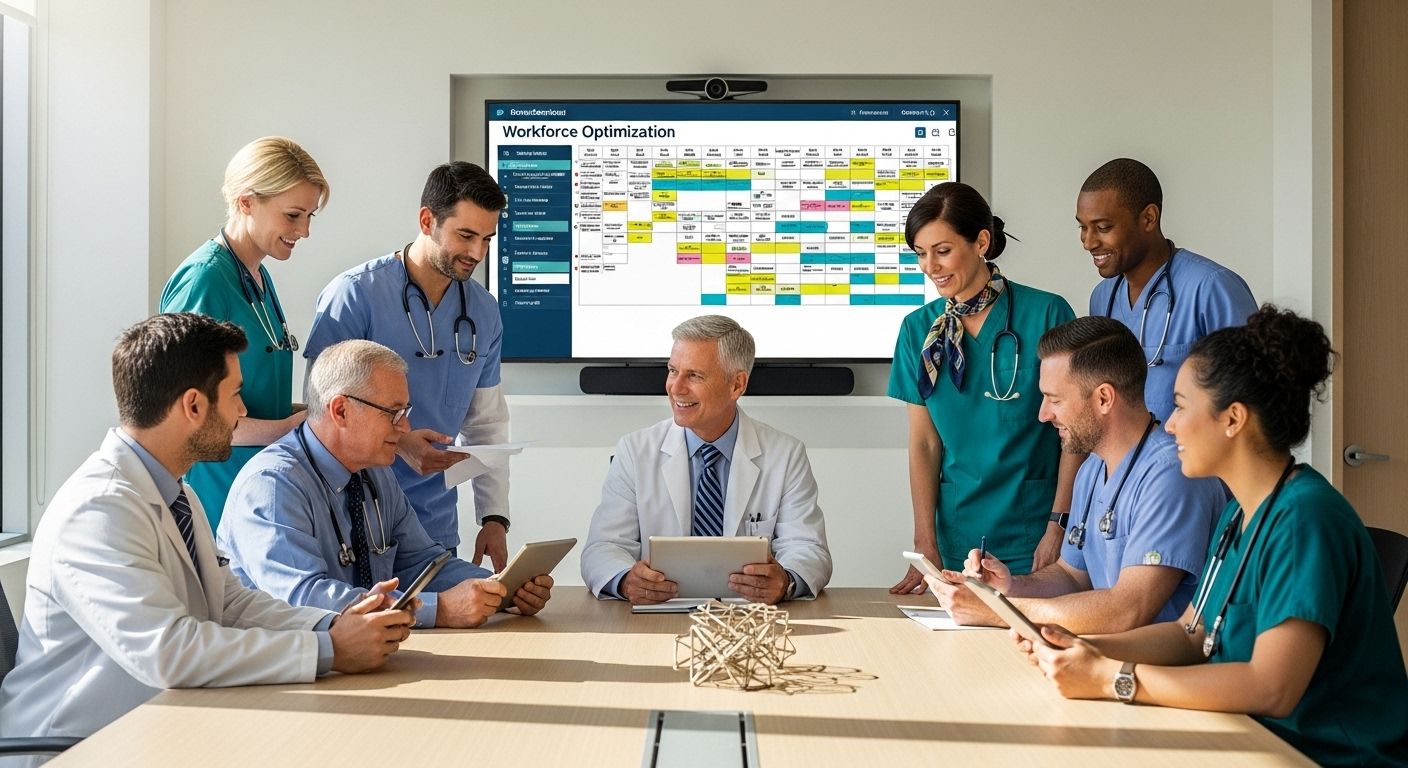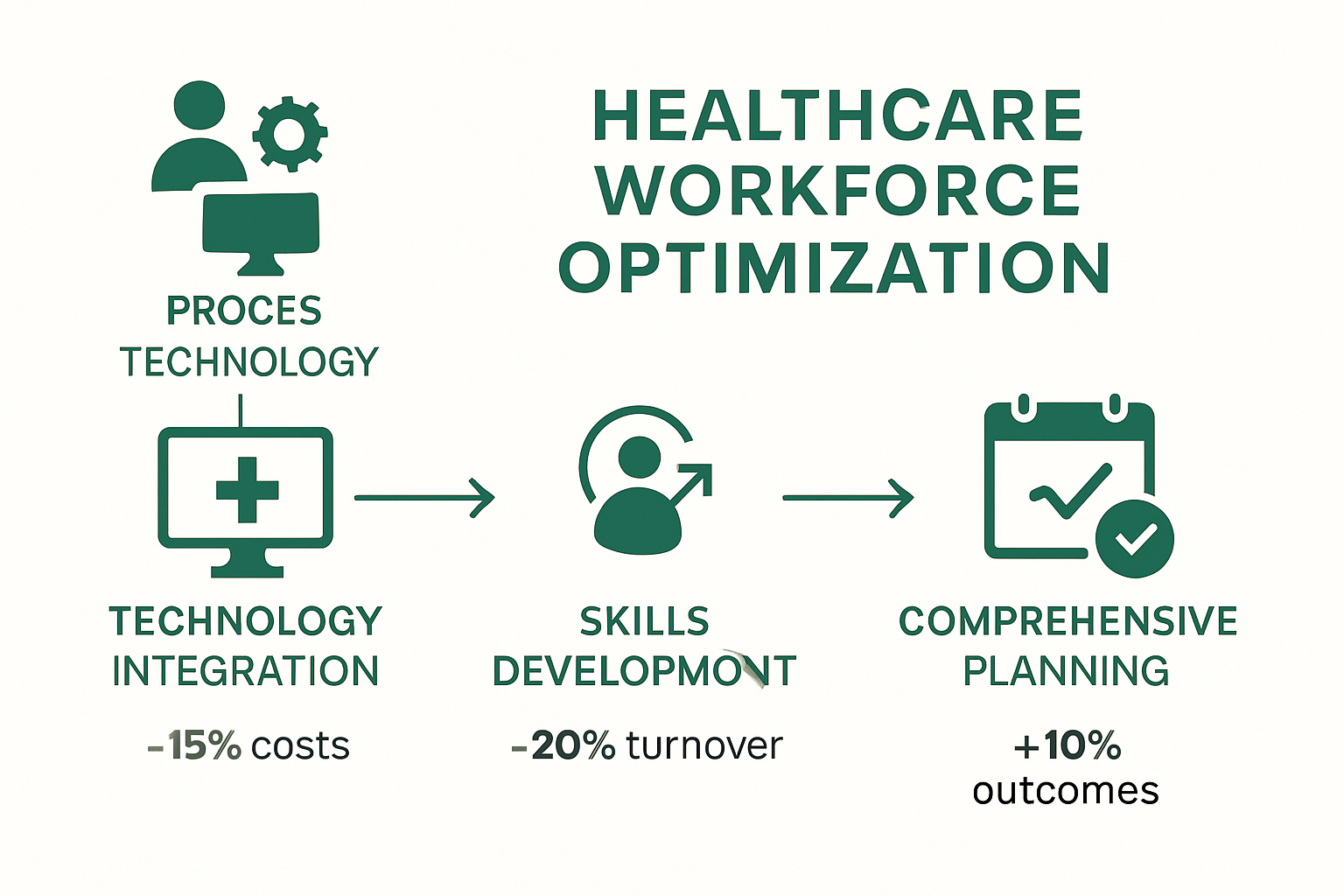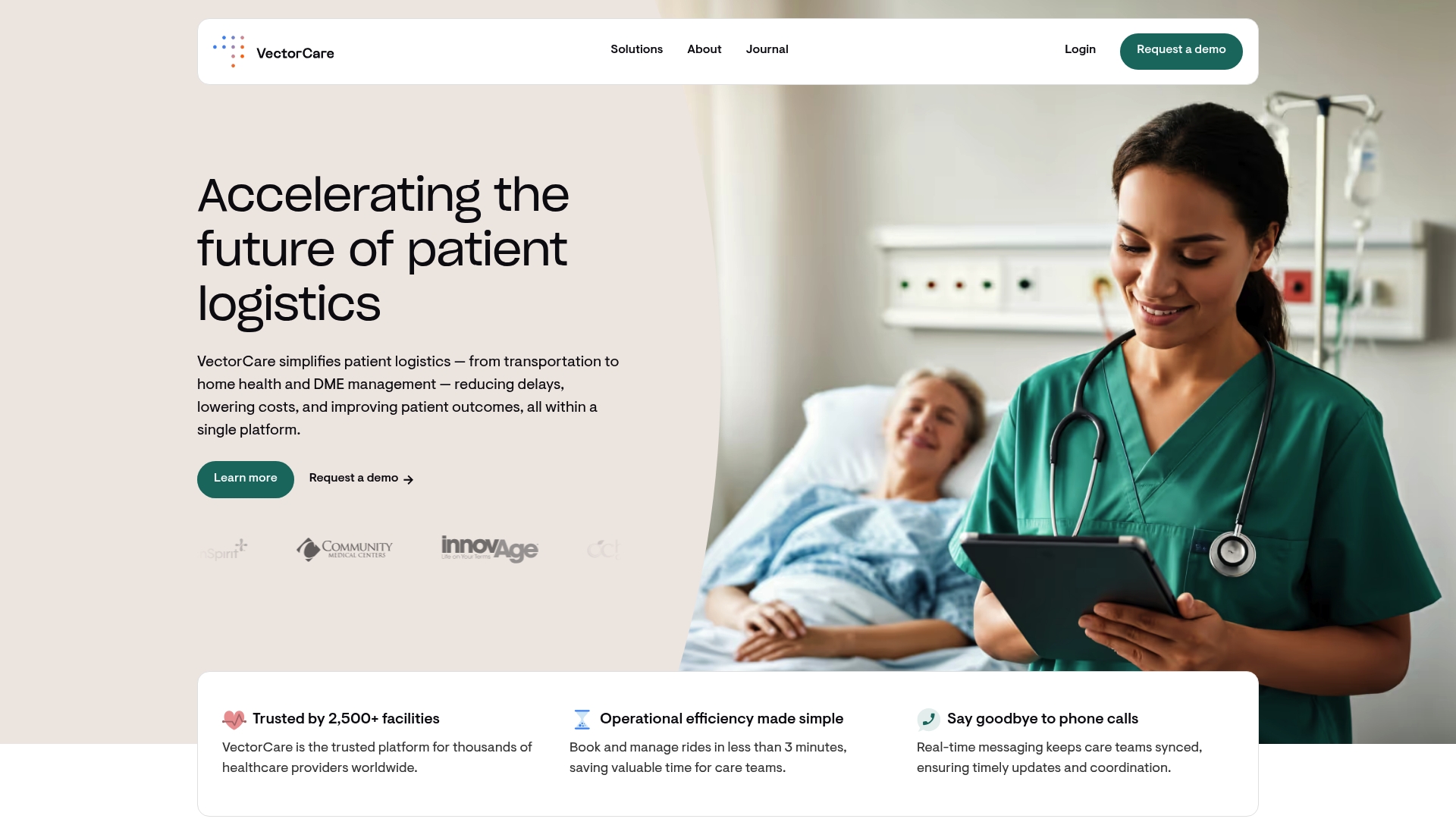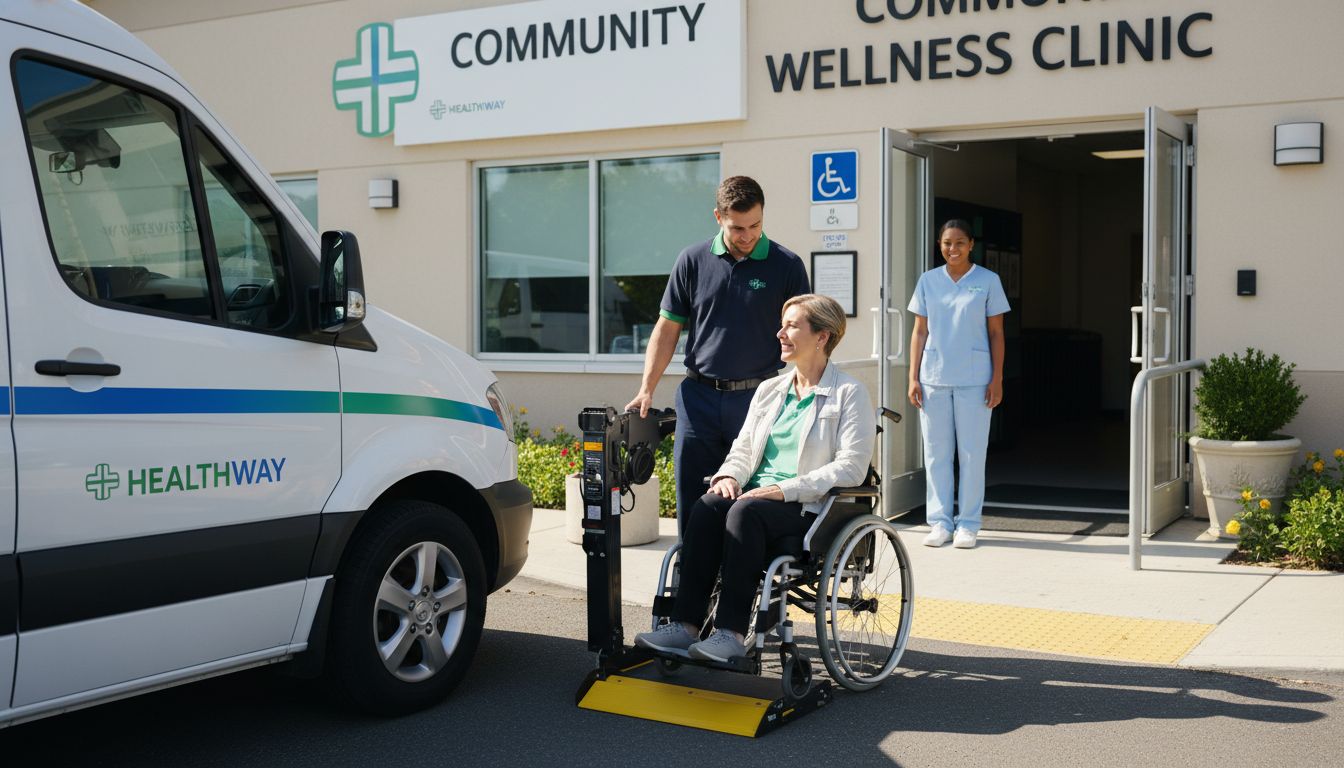Healthcare Workforce Optimization Strategies for 2025 Success

Healthcare staffing challenges are everywhere and hospitals constantly fight to keep up with patient needs. Yet, with all the buzz about workforce shortages, something unexpected is happening. New technology is allowing some facilities to see up to a 77 percent reduction in schedule creation time and even cut labor costs by 8 percent. The big surprise is that the secret to 2025 healthcare success may have nothing to do with hiring more people and everything to do with optimizing the team and tools you already have.
Table of Contents
- Understanding Healthcare Workforce Optimization
- Key Strategies For Efficient Staffing And Scheduling
- Leveraging Technology For Workforce Efficiency
- Improving Patient Care And Operational Outcomes
Quick Summary
| Takeaway | Explanation |
|---|---|
| Leverage predictive analytics for staffing | Use advanced analytics to accurately forecast staffing needs based on real data trends. |
| Implement comprehensive workforce planning | Ensure all aspects of workforce management align with patient demands and operational strategies. |
| Integrate technology to enhance efficiency | Use AI and automation to streamline scheduling and reduce manual workloads. |
| Expand roles through collaborative care models | Rethink staff responsibilities to maximize workforce potential and improve patient care. |
| Focus on continuous performance measurement | Establish robust metrics to assess workforce effectiveness and patient care outcomes. |
Understanding Healthcare Workforce Optimization
Healthcare workforce optimization represents a critical strategic approach for addressing the complex challenges facing modern healthcare systems. This comprehensive strategy goes beyond traditional workforce management to create a dynamic, adaptive framework that aligns human resources with emerging technological capabilities and patient care demands.
The Core Components of Workforce Optimization
At its foundation, healthcare workforce optimization encompasses a multifaceted approach to maximizing human capital within medical environments. Learn more about empowering healthcare professionals through strategic workforce management techniques. The primary objectives include improving operational efficiency, enhancing patient outcomes, and creating sustainable working environments for healthcare professionals.
According to research from the National Institutes of Health, effective workforce optimization strategies typically involve several key elements. These include advanced staffing models, technology integration, skill development, and comprehensive workforce planning that anticipates future healthcare needs. The approach recognizes that healthcare professionals are not just resources to be managed but critical assets whose potential must be strategically developed and supported.
Before diving deeper, here is a table summarizing the core components of healthcare workforce optimization and their main objectives:
| Component | Purpose/Objective |
|---|---|
| Advanced Staffing Models | Enhance efficiency and match workforce to demand |
| Technology Integration | Automate, analyze, and streamline operations |
| Skill Development | Promote professional growth and adaptability |
| Comprehensive Planning | Anticipate and prepare for future workforce needs |
| Workforce Well-being | Support sustainability and job satisfaction |

Technology and Human Potential
Modern healthcare workforce optimization leverages cutting-edge technologies to transform traditional workforce management paradigms. Artificial intelligence, predictive analytics, and machine learning are increasingly being deployed to create more intelligent staffing solutions. These technologies enable healthcare organizations to:
- Predict Workforce Needs: Analyze historical data and current trends to forecast staffing requirements
- Optimize Staff Scheduling: Create more efficient and flexible work arrangements
- Reduce Administrative Burden: Automate repetitive tasks to allow healthcare professionals to focus on patient care
The Journal of Patient Safety highlights that successful workforce optimization is not just about technological implementation but about creating a holistic approach that considers the well-being and professional development of healthcare workers.
As healthcare continues to evolve, workforce optimization will become increasingly critical. Organizations that can effectively balance technological innovation with human potential will be best positioned to address the complex challenges of modern healthcare delivery. This requires a forward-thinking approach that views workforce management as a strategic investment in both organizational capabilities and individual professional growth.
Key Strategies for Efficient Staffing and Scheduling
Efficient staffing and scheduling represent critical components of healthcare workforce optimization, directly impacting patient care quality, operational costs, and employee satisfaction. As healthcare organizations face increasing complexity and resource constraints, implementing strategic approaches to workforce management becomes paramount.
Predictive Staffing Technologies
Advanced predictive analytics are revolutionizing healthcare workforce management. Learn more about technology-driven workforce solutions that transform traditional scheduling methods. According to Modern Healthcare, predictive analytics enable healthcare organizations to forecast staffing needs with unprecedented accuracy. These technologies analyze historical data, patient volume trends, seasonal variations, and real-time operational demands to create intelligent scheduling frameworks.
The Queen’s Medical Center case study demonstrates the transformative potential of such technologies. By implementing advanced scheduling systems, they achieved a remarkable 77% reduction in schedule creation time and an 8% decrease in labor costs. This approach goes beyond simple cost-cutting, focusing on creating more responsive and adaptive workforce management strategies.
Below is a table highlighting the key impacts of predictive staffing technologies based on real-world case studies and research discussed above:
| Organization/Source | Technology Used | Key Result 1 | Key Result 2 |
|---|---|---|---|
| Queen’s Medical Center | Predictive scheduling system | 77% reduction in schedule creation time | 8% decrease in labor costs |
| General Healthcare Orgs. | Predictive analytics | More accurate staffing forecasts | Improved responsiveness |
| Leading Children’s Hospital (KPMG) | AI-powered centralized scheduling | Enhanced operational efficiency | Improved employee satisfaction |
Comprehensive Workforce Planning
Successful staffing strategies require a holistic approach that considers multiple dimensions of workforce management. Key elements include:
- Skills Matching: Align staff capabilities with specific departmental needs
- Flexible Scheduling: Create adaptable work arrangements that support work-life balance
- Continuous Training: Develop ongoing professional development programs
The KPMG case study of a leading children’s healthcare provider illustrates the potential of centralized, AI-powered scheduling. By standardizing policies and optimizing resource allocation, they significantly enhanced both operational efficiency and employee satisfaction.
Healthcare organizations must view staffing not as a static process but as a dynamic strategy that continuously adapts to changing patient needs, technological advancements, and workforce dynamics. This requires investment in sophisticated scheduling technologies, data-driven decision-making, and a commitment to supporting healthcare professionals through intelligent workforce management approaches. The future of healthcare staffing lies in creating flexible, responsive systems that balance organizational efficiency with individual professional growth and well-being.
Leveraging Technology for Workforce Efficiency
Technology has emerged as a transformative force in healthcare workforce optimization, offering unprecedented opportunities to enhance operational efficiency, reduce administrative burdens, and improve overall workforce productivity. As healthcare organizations navigate increasingly complex operational landscapes, strategic technological integration becomes crucial for sustainable workforce management.
Digital Transformation in Healthcare Workforce Management
Explore technology-driven workforce solutions that are reshaping healthcare operations. According to the Journal of Nursing Care Quality, emerging technologies are critical for preparing healthcare teams for future challenges. Artificial intelligence, machine learning, and advanced analytics platforms are no longer futuristic concepts but essential tools for real-time workforce optimization.
These technologies enable healthcare organizations to move beyond traditional reactive management approaches. By implementing intelligent systems, organizations can predict staffing needs, identify potential burnout risks, and create more dynamic and responsive workforce strategies. For instance, AI-powered platforms can analyze complex workforce data, including historical performance metrics, individual skill sets, and current operational demands, to generate highly optimized staffing recommendations.
Integrated Technology Ecosystems
Successful technological integration requires a comprehensive approach that goes beyond individual tools. Key technological strategies include:
- Interoperability: Develop seamless communication between different healthcare systems and platforms
- Real-time Analytics: Implement dashboards that provide immediate insights into workforce performance
- Automated Workflow Management: Reduce administrative tasks through intelligent automation
Modern healthcare workforce technology ecosystems are designed to support healthcare professionals by streamlining complex processes. These integrated systems not only improve operational efficiency but also create more supportive and responsive work environments. By reducing manual administrative tasks, technology allows healthcare professionals to focus more on patient care and professional development.
The future of healthcare workforce efficiency lies in creating adaptive, intelligent technological frameworks that can anticipate and respond to dynamic healthcare challenges. Organizations that successfully leverage technology will be better positioned to attract top talent, optimize resource allocation, and deliver high-quality patient care. This requires a strategic approach that views technology not as a replacement for human expertise, but as a powerful tool to augment and support healthcare professionals in their critical work.
Improving Patient Care and Operational Outcomes
Healthcare workforce optimization directly impacts patient care quality and organizational performance, creating a critical intersection between human resources management and clinical excellence. By strategically aligning workforce capabilities with patient needs, healthcare organizations can simultaneously enhance operational efficiency and improve patient outcomes.
Expanding Scope of Practice and Collaborative Care Models
Discover strategies for coordinating care platforms that transform healthcare delivery. According to research from the National Institutes of Health, post-pandemic healthcare requires innovative approaches to workforce management, including expanded scopes of practice and task-shifting strategies that maximize professional capabilities.
These collaborative care models involve redistributing clinical responsibilities across different healthcare professionals, allowing each team member to practice at the top of their licensure. For instance, nurse practitioners can take on more comprehensive primary care roles, while pharmacists might expand medication management responsibilities. This approach not only addresses workforce shortages but also creates more efficient patient care pathways.
Performance Measurement and Continuous Improvement
Effective workforce optimization requires robust performance measurement systems that go beyond traditional metrics. Key performance indicators now encompass a holistic view of patient care, including:
- Patient Satisfaction Scores: Measuring the quality of interpersonal interactions
- Clinical Outcome Metrics: Tracking treatment success and patient recovery rates
- Operational Efficiency: Evaluating resource utilization and care delivery speed
To clarify these key performance indicators, here is a table outlining typical workforce optimization metrics and what they evaluate:
| Performance Indicator | What It Measures | Impact on Organization |
|---|---|---|
| Patient Satisfaction Scores | Quality of staff-patient interactions | Patient loyalty, reputation |
| Clinical Outcome Metrics | Treatment success and recovery rates | Care effectiveness |
| Operational Efficiency | Resource use, speed of care delivery | Cost savings, throughput |
| Staff Satisfaction | Employee engagement and well-being | Retention, morale |
| Professional Development | Training and skill enhancement | Workforce adaptability |
By implementing comprehensive performance tracking, healthcare organizations can identify strengths, address potential gaps, and create targeted professional development strategies. This data-driven approach ensures that workforce optimization efforts directly contribute to enhanced patient care and organizational performance.
The future of healthcare workforce management lies in creating adaptive, responsive systems that recognize the intricate relationship between professional development, organizational strategy, and patient outcomes. Success requires a multifaceted approach that balances technological innovation, professional training, and a deep commitment to patient-centered care. Organizations that can effectively integrate these elements will not only improve operational efficiency but also create more meaningful, high-quality healthcare experiences for patients and professionals alike.

Frequently Asked Questions
What is healthcare workforce optimization?
Healthcare workforce optimization is a strategic approach designed to maximize the effectiveness of healthcare professionals and resources. It involves aligning staffing models, technology integration, and comprehensive planning to meet patient demands efficiently and improve care outcomes.
How can predictive staffing technologies improve healthcare operations?
Predictive staffing technologies analyze historical and real-time data to forecast staffing needs accurately. This leads to more efficient scheduling, reduced labor costs, and improved responsiveness to patient care demands.
What are some key strategies for efficient staffing in healthcare?
Key strategies include implementing predictive analytics for staffing forecasts, adopting comprehensive workforce planning, and creating flexible scheduling arrangements to match workforce capabilities with patient demands.
How does technology contribute to workforce efficiency in healthcare?
Technology contributes to workforce efficiency by automating repetitive administrative tasks, optimizing staff scheduling, and providing real-time analytics that enable healthcare organizations to make data-driven decisions about their workforce management.
Ready for Real Workforce Optimization? See How VectorCare Delivers
Every healthcare leader wants to solve problems like inefficient scheduling, rising labor costs, and the constant pressure to do more with less. If you found the promise of smarter staffing, predictive analytics, and operational efficiency inspiring in our article, just imagine the impact of bringing these strategies to your own team. With VectorCare’s digital platform, you can put technology-driven workforce optimization into action by automating patient logistics, reducing manual workloads, and gaining live insights across all your services. Find out how our platform transforms healthcare operations with smart scheduling and seamless coordination that helps you stay ahead.

Stop letting outdated systems create bottlenecks for your patients and your staff. Experience better efficiency, lower costs, and improved care with VectorCare’s automated patient logistics solutions. Visit our site now and explore how you can streamline workforce management and leave staffing headaches behind.



